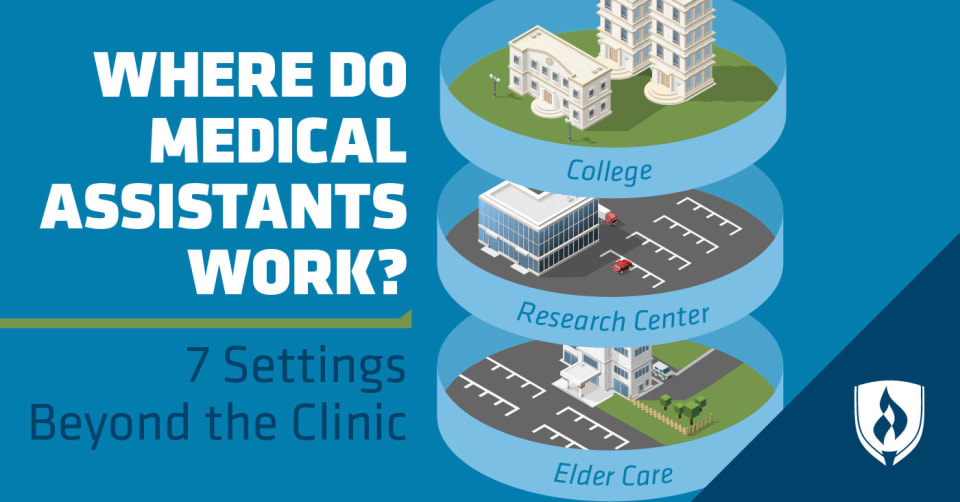There’s no denying the healthcare industry is huge. With dozens of medical professionals carrying out dozens of duties to keep dozens of facilities moving forward, it’s hard to keep track of the careers in this field.

It’s no wonder why you would want to work in this important, increasingly growing field. If you’re hoping to work directly with patients without spending years and years in school, you’ve probably considered medical assisting. This would allow you to start making an impact in as few as 12 months by earning a Medical Assisting Diploma.1
The roles and responsibilities align with your skills and interests, but you’re still left with one question: Where do medical assistants work? Would your employment options be limited to just clinical settings?
You’ll be happy to hear that the answer is no. The options for where you will clock in every day are much more numerous than that, according to Denise Pufall, Rasmussen University Medical Assisting Department Chair.
Keep reading to learn about the various work environments you could find yourself in as a medical assistant.
First things first …
Before we get into our list, we must first acknowledge the fact that medical clinics are by and large the most common employers of medical assistants (MAs). In fact, more than half of all MAs work in this setting, according to the U.S. Bureau of Labor Statistics (BLS).
Generally speaking, the work at a clinic is fairly predictable in hours and tasks. Most clinics have established business hours, with less probability of being open on weekends or major holidays. It should be noted, however, that not all clinics are the same. Some focus on specialties such as optometry, podiatry or neurology. Others handle a spectrum of medical issues like family practice or internal medicine.
Because employment at a clinic is more prevalent, it is common for MAs to get their start working in this setting. But after acquiring some experience, you may decide to seek a new challenge. It’s exciting to know you can expand your horizons if you so choose.
7 less common medical assistant work settings to consider
“Medical assistants are being utilized in many types of healthcare settings,” Pufall explains. “Once in the profession, you can obtain employment in many different types of settings that utilize medical assistants.”
Depending on your location, experience or personal preferences, you can find a medical assisting position that appeals to you. We used real-time job analysis software to identify some of the other settings available to MAs.2
Here are a few of the work environments you may encounter along your career path:
1. Hospitals
If you thrive in a faster, more unpredictable pace, a career working in a hospital may be the ticket. Hospitals, after all, are 24/7 operations that deal with everything from routine procedures to crisis care. The BLS reports that about 15 percent of all medical assistants clock in at a hospital. When you arrive at work, you never know how the day will unfold. Hospital MAs may have a sporadic work schedule, which could include days, night, overnights, weekends and holidays.
Depending on your specific assignment, working in a hospital requires someone who can handle stress. Hospital employees are exposed to emergency situations, which can be emotionally draining. But for those individuals who can handle these challenges, working in a hospital can be personally satisfying with the knowledge of providing essential services.
2. Outpatient care centers
Falling between a clinic and hospital, outpatient care centers are medical offices that provide services and procedures that do not require overnight stays. These offices offer a range of services, from performing minor surgery to running lab tests.
As a medical assistant in these facilities, you may take patient vital signs, assist with X-rays and complete administrative work. While it’s still busy, work at an outpatient care center is typically less hectic than the stress of a hospital because patients generally don’t have life-threatening conditions. Shifts are typically more predictable, but some outpatient facilities may be open evenings and weekends.
3. Colleges and universities
Some larger universities run their own hospitals and clinics, which is another employment option for medical assistants. For the most part, the roles and responsibilities will be similar to that of a normal hospital or clinic.
After acquiring your fair share of medical assisting experience, you may also have the opportunity to find employment as an adjunct or full-time instructor at a higher education institution. This would allow you to help educate and train the next generation of medical assistants. Becoming an instructor will likely include educational requirements above and beyond that typically required of an MA.
4. Medical research centers
Another option is to build a career working with researchers who are trying to advance the knowledge of the medical community. Tasks could range from signing in research participants to helping with the administering of tests. MAs in this environment are responsible for assisting researchers, playing a valuable role in the advancement of the medical field.
Other responsibilities could include various testing, labeling and shipping of diagnostic specimens. This type of work in a research center generally comes with more predictable and routine hours.
5. Diagnostic laboratories
If you prefer less direct patient contact, a diagnostic laboratory might be a good option for you. Clinics and hospitals ship specimen samples for testing to diagnostic clinics. As a medical assistant, your job could be to run tests on the samples, record results and handle input of data. Working in a diagnostic laboratory can also involve significant administrative work.
6. Insurance carriers
To process claims, insurance companies sometimes hire medical assistants to handle administrative details. This might include inputting data, working with medical billing offices and answering questions from insurance policyholders. Medical assistants are valuable for their knowledge of the medical profession. These jobs generally come with normal business hours and require prior medical assisting experience.
7. Nursing care facilities
If you have a passion for senior citizens, assisted living and nursing homes also offer opportunities for medical assistants. With the aging baby boomer generation, there is a growing demand for senior living services.
Medical assistants in this environment typically help residents with daily living tasks, take vital signs and maintain medical records. Residents will often see you as a trusted friend that goes beyond a caregiver, so it’s helpful to be open to building relationships. Because senior homes are 24/7 facilities, work shifts are not limited to normal business hours.
That’s only the beginning …
These seven options beyond the clinic are just a few of the choices for medical assistants. As mentioned, several of these opportunities will require prior medical assisting experience. It could also work to your advantage to get certified to make yourself more marketable.
“The best advice is to make sure you sit for the Certified Medical Assistant (CMA) exam,” Pufall advises. “This exam opens many medical assisting positions as it is becoming more desired by employers.”
Find your fit as a medical assistant
So where do medical assistants work? As it turns out, there are plenty of options. Now that you know you won’t be limited to working in a clinic, you may be even more interested in starting your career in the field.
Learn what you need to do to get started in our article, How to Become a Medical Assistant: 5 Steps You Can’t Skip.
RELATED ARTICLES:
- 12 Benefits of Becoming a Medical Assistant
- Medical Assisting Skills: What You Need to Be Confident in Your Career
- The Ultimate List of Healthcare Jobs You Can Launch in 2 Years or Less
1Completion time is dependent on transfer credits accepted and courses completed each term.
2Burning-Glass.com (Analysis of 101,928 job postings, Mar. 01, 2016–Feb. 28, 2017)




